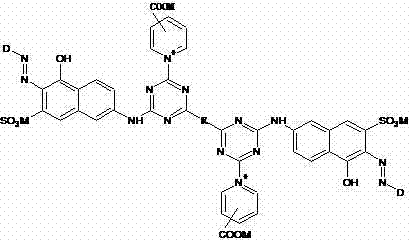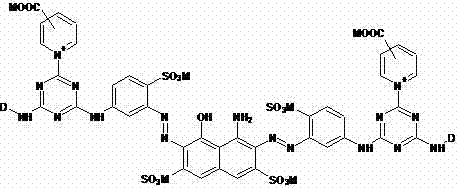Reactive dye printing paste for flat net or rotary screen printing and preparation method of reactive dye printing paste
A reactive dye and printing color paste technology, which is applied in the field of printing and dyeing industry, can solve the problems that there is no active dye printing color paste
- Summary
- Abstract
- Description
- Claims
- Application Information
AI Technical Summary
Problems solved by technology
Method used
Image
Examples
Embodiment 1
[0067] A reactive dye printing color paste for flat screen or rotary screen printing, the reactive dye printing color paste is made of reactive dyes, cosolvent, resist salt, printing paste and water, wherein the cosolvent is urea, and the resist Salt is sodium m-nitrobenzene sulfonate, printing paste is sodium carboxymethyl starch, and the mass percent of each component is as shown in table 1, and described reactive dyestuff is made up of following four kinds of reactive dyestuff compounds, and each reactive dyestuff compound See Table 2 for mass percentages;
[0068] 1), red reactive dye compound, the structure is shown in formula (I):
[0069]
[0070] (I)
[0071] M in the formula (I) is hydrogen, and R is a bridging group, specifically:
[0072] , M in the bridging base is hydrogen, and D in formula (I) is , wherein M is hydrogen;
[0073] 2), yellow reactive dye compound, the structure is shown in formula (II):
[0074]
[0075] (II)
[0076] In formula (II...
Embodiment 2
[0098] A reactive dye printing color paste for flat screen or rotary screen printing, the reactive dye printing color paste is made of reactive dyes, cosolvent, resist salt, printing paste and water, wherein the cosolvent is thiourea, anti The dyeing salt is sodium m-nitrobenzenesulfonate, and the printing paste is sodium carboxymethyl cellulose fiber. The mass percentages of each component are shown in Table 1. The composition of each reactive dye compound in the reactive dye is shown in Table 2. Blue The composition of color reactive dye compound is shown in Table 3, and the basic structure of each reactive dye compound is the same as embodiment 1, and difference is:
[0099] In the formula (II), M is Na, Q is -NHCONH 2 , R is the abutment, specifically:
[0100] , , M in the abutment is Na, formula (II) D is , where M is Na;
[0101] In the formula (III), M is Na, and R is a bridging group, specifically:
[0102] , where M is Na, D in formula (III) is , where M i...
Embodiment 3
[0110] A reactive dye printing color paste for flat screen or rotary screen printing, the reactive dye printing color paste is made of reactive dyes, cosolvent, resist salt, printing paste and water, wherein the cosolvent is urea, and the resist Salt is sodium m-nitrobenzenesulfonate, printing paste is sodium alginate, and the mass percent of each component is as shown in Table 1, and each reactive dye compound composition in described reactive dye is shown in Table 2, and the blue reactive dye compound The composition is shown in Table 3, and the basic structure of each reactive dye compound is the same as in Example 1, and the difference is:
[0111] M in the formula (I) is hydrogen, and R is a bridging group, specifically:
[0112] , D in formula (I) is ;
[0113] In the formula (III), M is hydrogen, and R is a bridging group, specifically:
[0114] , D in formula (III) is Wherein M is hydrogen;
[0115] In formula (IV), M is hydrogen, and D is ;
[0116] In f...
PUM
 Login to View More
Login to View More Abstract
Description
Claims
Application Information
 Login to View More
Login to View More - R&D
- Intellectual Property
- Life Sciences
- Materials
- Tech Scout
- Unparalleled Data Quality
- Higher Quality Content
- 60% Fewer Hallucinations
Browse by: Latest US Patents, China's latest patents, Technical Efficacy Thesaurus, Application Domain, Technology Topic, Popular Technical Reports.
© 2025 PatSnap. All rights reserved.Legal|Privacy policy|Modern Slavery Act Transparency Statement|Sitemap|About US| Contact US: help@patsnap.com



